Hydraulic and Mechanical Impacts of Pore Space Alterations within a Sandstone Quantified by a Flow Velocity-Dependent Precipitation Approach
Abstract
:1. Introduction
2. Material and Methods
2.1. Digital Rock Sample and Morphology of the Pore Space
2.2. Permeability Determination and Pore Space Alteration Mechanisms
2.3. Calculation of Elastic Rock Properties
3. Results
3.1. Morphology of the Pore Space
3.2. Flow Field and Permeability
3.3. Elastic Rock Properties
4. Discussion
4.1. Range of the Porosity-Permeability Relation
4.2. Impact on Elastic Rock Properties
4.3. Added Value of Using a Velocity-Dependent Precipitation Algorithm
5. Summary and Conclusions
Author Contributions
Funding
Acknowledgments
Conflicts of Interest
References
- Jacquey, A.B.; Cacace, M.; Blöcher, G.; Watanabe, N.; Huenges, E.; Scheck-Wenderoth, M. Thermo-poroelastic numerical modelling for enhanced geothermal system performance: Case study of the Groß Schönebeck reservoir. Tectonophysics 2016, 684, 119–130. [Google Scholar] [CrossRef]
- Wagner, R.; Kühn, M.; Meyn, V.; Pape, H.; Vath, U.; Clauser, C. Numerical simulation of pore space clogging in geothermal reservoirs by precipitation of anhydrite. Int. J. Rock Mech. Min. Sci. 2005, 42, 1070–1081. [Google Scholar] [CrossRef]
- Moghadasi, J.; Müller-Steinhagen, H.; Jamialahmadi, M.; Sharif, A. Model study on the kinetics of oil field formation damage due to salt precipitation from injection. J. Pet. Sci. Eng. 2004, 43, 201–217. [Google Scholar] [CrossRef]
- Kleinitz, W.; Koehler, M.; Dietzsch, G. The precipitation of salt in gas producing wells. In Proceedings of the SPE European Formation Damage Conference, The Hague, The Netherlands, 21–22 May 2001; pp. 295–301. [Google Scholar] [CrossRef]
- Alexander, W.; Reijonen, H.; McKinley, I. Natural analogues: Studies of geological processes relevant to radioactive waste disposal in deep geological repositories. Swiss J. Geosci. 2015, 108, 75–100. [Google Scholar] [CrossRef]
- Fall, M.; Nasir, O.; Nguyen, T.S. A coupled hydro-mechanical model for simulation of gas migration in host sedimentary rocks for nuclear waste repositories. Eng. Geol. 2014, 176, 24–44. [Google Scholar] [CrossRef] [Green Version]
- Fischer, S.; Liebscher, A.; Zemke, K.; De Lucia, M.; Team, K. Does injected CO2 affect (chemical) reservoir system integrity?-A comprehensive experimental approach. Energy Procedia 2013, 37, 4473–4482. [Google Scholar] [CrossRef] [Green Version]
- Fischer, S.; De Lucia, M.; Liebscher, A. Kinetic modeling of laboratory CO2-exposure experiments performed on whole rock reservoir samples. Greenh. Gases Sci. Technol. 2014, 4, 244–256. [Google Scholar] [CrossRef]
- Ma, J.; Li, Q.; Kühn, M.; Nakaten, N. Power-to-gas based subsurface energy storage: A review. Renew. Sustain. Energy Rev. 2018, 97, 478–496. [Google Scholar] [CrossRef]
- Peysson, Y.; Bazin, B.; Magnier, C.; Kohler, E.; Youssef, S. Permeability alteration due to salt precipitation driven by drying in the context of CO2 injection. Energy Procedia 2011, 4, 4387–4394. [Google Scholar] [CrossRef] [Green Version]
- Regenspurg, S.; Feldbusch, E.; Byrne, J.; Deon, F.; Driba, D.L.; Henninges, J.; Kappler, A.; Naumann, R.; Reinsch, T.; Schubert, C. Mineral precipitation during production of geothermal fluid from a Permian Rotliegend reservoir. Geothermics 2015, 54, 122–135. [Google Scholar] [CrossRef]
- Kühn, M.; Clauser, C. Mineralische Bindung von CO2 bei der Speicherung im Untergrund in geothermischen Reservoiren. Chem. Ing. Tech. 2006, 78, 425–434. [Google Scholar] [CrossRef]
- Patil, V.V.; McPherson, B.J.; Priewisch, A.; Moore, J.; Moodie, N. Factors affecting self-sealing of geological faults due to CO2-leakage. Greenh. Gases Sci. Technol. 2017, 7, 273–294. [Google Scholar] [CrossRef]
- Tobler, D.J.; Minto, J.M.; El Mountassir, G.; Lunn, R.J.; Phoenix, V.R. Microscale analysis of fractured rock sealed with microbially induced CaCO3 precipitation: Influence on hydraulic and mechanical performance. Water Resour. Res. 2018, 54, 8295–8308. [Google Scholar] [CrossRef] [Green Version]
- Yasuhara, H.; Kinoshita, N.; Lee, D.S.; Choi, J.; Kishida, K. Evolution of mechanical and hydraulic properties in sandstone induced by simulated mineral trapping of CO2 geo-sequestration. Int. J. Greenh. Gas Control 2017, 56, 155–164. [Google Scholar] [CrossRef] [Green Version]
- Cil, M.B.; Xie, M.; Packman, A.I.; Buscarnera, G. Solute mixing regulates heterogeneity of mineral precipitation in porous media. Geophys. Res. Lett. 2017, 44, 6658–6666. [Google Scholar] [CrossRef]
- Tartakovsky, A.M.; Redden, G.; Lichtner, P.C.; Scheibe, T.D.; Meakin, P. Mixing-induced precipitation: Experimental study and multiscale numerical analysis. Water Resour. Res. 2008, 44, 1–19. [Google Scholar] [CrossRef]
- Fazeli, H.; Masoudi, M.; Patel, R.A.; Aagaard, P.; Hellevang, H. Pore-scale modeling of nucleation and growth in porous media. ACS Earth Space Chem. 2020. [Google Scholar] [CrossRef]
- Godinho, J.R.; Gerke, K.M.; Stack, A.G.; Lee, P.D. The dynamic nature of crystal growth in pores. Sci. Rep. 2016, 6, 1–7. [Google Scholar] [CrossRef] [Green Version]
- Lin, Y.P.; Singer, P.C. Effects of seed material and solution composition on calcite precipitation. Geochim. Cosmochim. Acta 2005, 69, 4495–4504. [Google Scholar] [CrossRef]
- Noiriel, C.; Steefel, C.I.; Yang, L.; Bernard, D. Effects of pore-scale precipitation on permeability and flow. Adv. Water Resour. 2016, 95, 125–137. [Google Scholar] [CrossRef] [Green Version]
- Bartels, J.; Kühn, M.; Schneider, W.; Clauser, C.; Pape, H.; Meyn, V.; Lajcsak, I. Core flooding laboratory experiment validates numerical simulation of induced permeability change in reservoir sandstone. Geophys. Res. Lett. 2002, 29, 34-1–34-4. [Google Scholar] [CrossRef]
- Schepers, A.; Milsch, H. Dissolution-precipitation reactions in hydrothermal experiments with quartz-feldspar aggregates. Contrib. Mineral. Petrol. 2013, 165, 83–101. [Google Scholar] [CrossRef]
- Beckingham, L.E. Evaluation of macroscopic porosity-permeability relationships in heterogeneous mineral dissolution and precipitation scenarios. Water Resour. Res. 2017, 53, 10217–10230. [Google Scholar] [CrossRef] [Green Version]
- Emmanuel, S.; Berkowitz, B. Effects of pore-size controlled solubility on reactive transport in heterogeneous rock. Geophys. Res. Lett. 2007, 34, 1–5. [Google Scholar] [CrossRef]
- Hedges, L.O.; Whitelam, S. Patterning a surface so as to speed nucleation from solution. Soft Matter 2012, 8, 8624–8635. [Google Scholar] [CrossRef] [Green Version]
- Tenthorey, E.; Scholz, C.H. Mapping secondary mineral formation in porous media using heavy metal tracers. J. Geophys. Res. Solid Earth 2002, 107, ECV 2-1–ECV 2-12. [Google Scholar] [CrossRef]
- Kozeny, J. Über kapillare Leitung des Wassers im Boden. Sitzungsberichte der Akad. der Wiss. Wien 1927, 136, 271–306. [Google Scholar]
- Verma, A.; Pruess, K. Thermohydrological conditions and silica redistribution near high-level nuclear wastes emplaced in saturated geological formations. J. Geophys. Res. Solid Earth 1988, 93, 1159–1173. [Google Scholar] [CrossRef] [Green Version]
- Marshall, T.J. A relation between permeability and size distribution of pores. J. Soil Sci. 1958, 9, 1–8. [Google Scholar] [CrossRef]
- Dvorkin, J.; Nur, A. Elasticity of high-porosity sandstones: Theory for two North Sea data sets. Geophysics 1996, 61, 890–893. [Google Scholar] [CrossRef]
- Hill, R. A self-consistent mechanics of composite materials. J. Mech. Phys. Solids 1965, 13, 213–222. [Google Scholar] [CrossRef]
- Mori, T.; Tanaka, K. Average stress in matrix and average elastic energy of materials with misfitting inclusions. Acta Metall. 1973, 21, 571–574. [Google Scholar] [CrossRef]
- Mostaghimi, P.; Blunt, M.J.; Bijeljic, B. Computations of absolute permeability on micro-CT images. Math. Geosci. 2013, 45, 103–125. [Google Scholar] [CrossRef]
- Wetzel, M.; Kempka, T.; Kühn, M. Predicting macroscopic elastic rock properties requires detailed information on microstructure. Energy Procedia 2017, 125, 561–570. [Google Scholar] [CrossRef]
- Blunt, M.J.; Bijeljic, B.; Dong, H.; Gharbi, O.; Iglauer, S.; Mostaghimi, P.; Paluszny, A.; Pentland, C. Pore-scale imaging and modelling. Adv. Water Resour. 2013, 51, 197–216. [Google Scholar] [CrossRef] [Green Version]
- Herring, A.L.; Middleton, J.; Walsh, R.; Kingston, A.; Sheppard, A. Flow rate impacts on capillary pressure and interface curvature of connected and disconnected fluid phases during multiphase flow in sandstone. Adv. Water Resour. 2017, 107, 460–469. [Google Scholar] [CrossRef]
- Raeini, A.Q.; Blunt, M.J.; Bijeljic, B. Direct simulations of two-phase flow on micro-CT images of porous media and upscaling of pore-scale forces. Adv. Water Resour. 2014, 74, 116–126. [Google Scholar] [CrossRef]
- Saenger, E. Numerical methods to determine effective elastic properties. Int. J. Eng. Sci. 2008, 46, 598–605. [Google Scholar] [CrossRef]
- Shulakova, V.; Sarout, J.; Pimienta, L.; Lebedev, M.; Mayo, S.; Clennell, M.; Pervukhina, M. Effect of supercritical CO2 on carbonates: Savonnières sample case study. Geophys. Prospect. 2017, 65, 251–265. [Google Scholar] [CrossRef] [Green Version]
- Andrä, H.; Combaret, N.; Dvorkin, J.; Glatt, E.; Han, J.; Kabel, M.; Keehm, Y.; Krzikalla, F.; Lee, M.; Madonna, C.; et al. Digital rock physics benchmarks-part II: Computing effective properties. Comput. Geosci. 2013, 50, 33–43. [Google Scholar] [CrossRef]
- Raeini, A.Q.; Blunt, M.J.; Bijeljic, B. Modelling two-phase flow in porous media at the pore scale using the volume-of-fluid method. J. Comput. Phys. 2012, 231, 5653–5668. [Google Scholar] [CrossRef]
- Garboczi, E.J.; Day, A.R. An algorithm for computing the effective linear elastic properties of heterogeneous materials: Three-dimensional results for composites with equal phase poisson ratios. J. Mech. Phys. Solids 1995, 43, 1349–1362. [Google Scholar] [CrossRef]
- Bakker, R.R.; Barnhoorn, A. Multiscale evaluation of potential damage in jetted lateral boreholes. Int. J. Rock Mech. Min. Sci. 2019, 121, 104007. [Google Scholar] [CrossRef]
- Jacquey, A.B.; Cacace, M.; Blöcher, G.; Watanabe, N.; Scheck-Wenderoth, M. Hydro-mechanical evolution of transport properties in porous media: Constraints for numerical simulations. Transp. Porous Media 2015, 110, 409–428. [Google Scholar] [CrossRef]
- Peksa, A.E.; Wolf, K.H.A.; Zitha, P.L. Bentheimer sandstone revisited for experimental purposes. Mar. Pet. Geol. 2015, 67, 701–719. [Google Scholar] [CrossRef]
- Herring, A.; Sheppard, A.; Turner, M.; Beeching, L. Multiphase Flows in Sandstones. Available online: http://www.digitalrocksportal.org/projects/135 (accessed on 17 February 2020). [CrossRef]
- Herring, A.L.; Robins, V.; Sheppard, A.P. Topological Persistence for Relating Microstructure and Capillary Fluid Trapping in Sandstones. Water Resour. Res. 2019, 55, 555–573. [Google Scholar] [CrossRef] [Green Version]
- Otsu, N. A threshold selection method from gray-level histograms. IEEE Trans. Syst. Man Cybern. 1979, 9, 62–66. [Google Scholar] [CrossRef] [Green Version]
- Klein, E.; Reuschlé, T. A model for the mechanical behaviour of Bentheim sandstone in the brittle regime. Thermo-Hydro-Mech. Coupling Fract. Rock 2003, 160, 833–849. [Google Scholar] [CrossRef]
- Maier, O. MedPy 0.4.0-Medical Image Processing in Python. Available online: https://pypi.org/project/MedPy/ (accessed on 12 January 2020).
- Gostick, J.; Khan, Z.; Tranter, T.; Kok, M.; Agnaou, M.; Sadeghi, M.; Jervis, R. PoreSpy: A python toolkit for quantitative analysis of porous media images. J. Open Source Softw. 2019, 4, 1296. [Google Scholar] [CrossRef]
- Liu, Z.; Herring, A.; Arns, C.; Berg, S.; Armstrong, R.T. Pore-scale characterization of two-phase flow using integral geometry. Transp. Porous Media 2017, 118, 99–117. [Google Scholar] [CrossRef]
- Weller, H.G.; Tabor, G.; Jasak, H.; Fureby, C. A tensorial approach to computational continuum mechanics using object-oriented techniques. Comput. Phys. 1998, 12, 620–631. [Google Scholar] [CrossRef]
- Bear, J. Dynamics of Fluids in Porous Media; Elsevier: New York, NY, USA, 1988. [Google Scholar]
- Baek, S.H.; Hong, J.W.; Kim, K.Y.; Yeom, S.; Kwon, T.H. X-ray computed microtomography imaging of abiotic carbonate precipitation in porous media from a supersaturated solution: Insights into effect of CO2 mineral trapping on Permeability. Water Resour. Res. 2019, 55, 3835–3855. [Google Scholar] [CrossRef] [Green Version]
- Crandell, L.E.; Peters, C.A.; Um, W.; Jones, K.W.; Lindquist, W.B. Changes in the pore network structure of Hanford sediment after reaction with caustic tank wastes. J. Contam. Hydrol. 2012, 131, 89–99. [Google Scholar] [CrossRef] [PubMed]
- Faisal, T.; Awedalkarim, A.; Chevalier, S.; Jouini, M.; Sassi, M. Direct scale comparison of numerical linear elastic moduli with acoustic experiments for carbonate rock X-ray CT scanned at multi-resolutions. J. Pet. Sci. Eng. 2017, 152, 653–663. [Google Scholar] [CrossRef]
- Knackstedt, M.; Latham, S.; Madadi, M.; Sheppard, A.; Varslot, T. Digital rock physics: 3D imaging of core material and correlations to acoustic and flow properties. Lead. Edge 2009, 28, 28–33. [Google Scholar] [CrossRef]
- Shulakova, V.; Pervukhina, M.; Tobias, M.; Lebedev, M.; Mayo, S.; Schmid, S.; Golodoniuc, P.; Paula, O.B.; Clennell, M.; Gurevich, B. Computational elastic up-scaling of sandstone on the basis of X-ray micro-tomographic images. Geophys. Prospect. 2013, 287–301. [Google Scholar] [CrossRef]
- Bohn, R.B.; Garboczi, E.J. User Manual for Finite Element and Finite Difference Programs: A Parallel Version of NIST IR 6269; Building and Fire Research Laboratory, National Institute of Standards and Technology: Gaithersburg, MD, USA, 2003. [Google Scholar] [CrossRef]
- Madonna, C.; Almqvist, B.; Saenger, E.H. Digital rock physics: Numerical prediction of pressure-dependent ultrasonic velocities using micro-CT imaging. Geophys. J. Int. 2012, 189, 1475–1482. [Google Scholar] [CrossRef] [Green Version]
- Saenger, E.H.; Enzmann, F.; Keehm, Y.; Steeb, H. Digital rock physics: Effect of fluid viscosity on effective elastic properties. J. Appl. Geophys. 2011, 74, 2140–2144. [Google Scholar] [CrossRef]
- Farhana Faisal, T.; Islam, A.; Jouini, M.S.; Devarapalli, R.S.; Jouiad, M.; Sassi, M. Numerical prediction of carbonate elastic properties based on multi-scale imaging. Geomech. Energy Environ. 2019, 20, 100125. [Google Scholar] [CrossRef]
- Pimienta, L.; Borgomano, J.V.; Fortin, J.; Guéguen, Y. Elastic dispersion and attenuation in fully saturated sandstones: Role of mineral content, porosity, and pressures. J. Geophys. Res. Solid Earth 2017, 122, 9950–9965. [Google Scholar] [CrossRef] [Green Version]
- Mavko, G.; Mukerji, T.; Dovorkin, J. The Rock Physics Handbook-Tools for Seismic Analysis of Porous Media, 2nd ed.; Cambridge University Press: Cambridge, UK, 2009; p. 522. [Google Scholar] [CrossRef]
- Mahabadi, O.; Randall, N.; Zong, Z.; Grasselli, G. A novel approach for micro-scale characterization and modeling of geomaterials incorporating actual material heterogeneity. Geophys. Res. Lett. 2012, 39, L01303. [Google Scholar] [CrossRef]
- Benson, P.M.; Meredith, P.G.; Platzman, E.S.; White, R.E. Pore fabric shape anisotropy in porous sandstones and its relation to elastic wave velocity and permeability anisotropy under hydrostatic pressure. Int. J. Rock Mech. Min. Sci. 2005, 42, 890–899. [Google Scholar] [CrossRef]
- Mayr, S.I.; Burkhardt, H. Ultrasonic properties of sedimentary rocks: Effect of pressure, saturation, frequency and microcracks. Geophys. J. Int. 2006, 164, 246–258. [Google Scholar] [CrossRef] [Green Version]
- Mikhaltsevitch, V.; Lebedev, M.; Gurevich, B.; Sun, Y.; Glubokovskikh, S. A seismic-frequency laboratory study of solid substitution in Bentheim sandstone. J. Geophys. Res. Solid Earth 2019, 124, 5492–5499. [Google Scholar] [CrossRef]
- Saenger, E.; Lebedev, M.; Uribe, D.; Osorno, M.; Vialle, S.; Duda, M.; Iglauer, S.; Steeb, H. Analysis of high-resolution X-ray computed tomography images of Bentheim sandstone under elevated confining pressures. Geophys. Prospect. 2016, 64, 848–859. [Google Scholar] [CrossRef]
- Yurikov, A.; Lebedev, M.; Gor, G.Y.; Gurevich, B. Sorption-induced deformation and elastic weakening of Bentheim sandstone. J. Geophys. Res. Solid Earth 2018, 123, 8589–8601. [Google Scholar] [CrossRef]
- Eberhart-Phillips, D.; Han, D.H.; Zoback, M. Empirical relationships among seismic velocity, effective pressure, porosity, and clay content in sandstone. Geophysics 1989, 54, 82–89. [Google Scholar] [CrossRef]
- Noiriel, C.; Daval, D. Pore-scale geochemical reactivity associated with CO2 storage: New frontiers at the fluid-solid interface. Acc. Chem. Res. 2017, 50, 759–768. [Google Scholar] [CrossRef]
- McNamara, D.D.; Lister, A.; Prior, D.J. Calcite sealing in a fractured geothermal reservoir: Insights from combined EBSD and chemistry mapping. J. Volcanol. Geotherm. Res. 2016, 323, 38–52. [Google Scholar] [CrossRef] [Green Version]
- Faatz, M.; Cheng, W.; Wegner, G.; Fytas, G.; Penciu, R.S.; Economou, E. Mechanical strength of amorphous CaCO3 colloidal spheres. Langmuir 2005, 21, 6666–6668. [Google Scholar] [CrossRef]
- Reinicke, A. Mechanical and Hydraulic Aspects of Rock-Proppant Systems-Laboratory Experiments and Modelling Approaches. Ph.D. Thesis, Deutsches GeoForschungsZentrum GFZ, Potsdam, Germany, November 2011. [Google Scholar] [CrossRef]
- Yalaev, T.; Bayuk, I.; Tarelko, N.; Abashkin, V. Connection of elastic and thermal properties of Bentheimer sandstone using effective medium theory (Rock physics). In Proceedings of the 50th U.S. Rock Mechanics/Geomechanics Symposium, Houston, TX, USA, 26–29 June 2016; pp. 1–7. [Google Scholar]
- Hossain, M.M.; Arns, J.Y.; Liang, Z.; Chen, Z.; Arns, C.H. Humidity effects on effective elastic properties of rock: An integrated experimental and numerical study. J. Geophys. Res. Solid Earth 2019, 124, 7771–7791. [Google Scholar] [CrossRef]
- Niu, Q.; Zhang, C. Permeability prediction in rocks experiencing mineral precipitation and dissolution: A numerical study. Water Resour. Res. 2019, 55, 3107–3121. [Google Scholar] [CrossRef]
- Nogues, J.P.; Fitts, J.P.; Celia, M.A.; Peters, C.A. Permeability evolution due to dissolution and precipitation of carbonates using reactive transport modeling in pore networks. Water Resour. Res. 2013, 49, 6006–6021. [Google Scholar] [CrossRef]
- Ostvar, S.; Iltis, G.; Davit, Y.; Schlüter, S.; Andersson, L.; Wood, B.D.; Wildenschild, D. Investigating the influence of flow rate on biofilm growth in three dimensions using microimaging. Adv. Water Resour. 2018, 117, 1–13. [Google Scholar] [CrossRef] [Green Version]
- Scheidweiler, D.; Peter, H.; Pramateftaki, P.; de Anna, P.; Battin, T.J. Unraveling the biophysical underpinnings to the success of multispecies biofilms in porous environments. ISME J. 2019, 13, 1700–1710. [Google Scholar] [CrossRef] [PubMed] [Green Version]
- Hommel, J.; Coltman, E.; Class, H. Porosity–permeability relations for evolving pore space: A review with a focus on (bio-)geochemically altered porous media. Transp. Porous Media 2018, 124, 589–629. [Google Scholar] [CrossRef] [Green Version]
- Carman, P.C. Fluid flow through granular beds. Trans. Inst. Chem. Eng. 1937, 15, 150–166. [Google Scholar] [CrossRef]
- Xie, M.; Mayer, K.U.; Claret, F.; Alt-Epping, P.; Jacques, D.; Steefel, C.; Chiaberge, C.; Simunek, J. Implementation and evaluation of permeability-porosity and tortuosity-porosity relationships linked to mineral dissolution-precipitation. Comput. Geosci. 2015, 19, 655–671. [Google Scholar] [CrossRef] [Green Version]
- Civan, F. Predictability of porosity and permeability alterations by geochemical and geomechanical rock and fluid interactions. In Proceedings of the SPE International Symposium on Formation Damage Control, Lafayette, LA, USA, 23–24 February 2000; pp. 359–370. [Google Scholar] [CrossRef]
- Yasuhara, H.; Neupane, D.; Hayashi, K.; Okamura, M. Experiments and predictions of physical properties of sand cemented by enzymatically-induced carbonate precipitation. Soils Found. 2012, 52, 539–549. [Google Scholar] [CrossRef] [Green Version]
- Zhang, L.; Soong, Y.; Dilmore, R.; Lopano, C. Numerical simulation of porosity and permeability evolution of Mount Simon sandstone under geological carbon sequestration conditions. Chem. Geol. 2015, 403, 1–12. [Google Scholar] [CrossRef] [Green Version]
- Bernabé, Y.; Mok, U.; Evans, B. Permeability-porosity relationships in rocks subjected to various evolution processes. Thermo-Hydro-Mech. Coupling Fract. Rock 2003, 160, 937–960. [Google Scholar] [CrossRef]
- Aharonov, E.; Tenthorey, E.; Scholz, C.H. Precipitation sealing and diagenesis: 2. Theoretical analysis. J. Geophys. Res. Solid Earth 1998, 103, 23969–23981. [Google Scholar] [CrossRef]
- Voigt, W. Über die Beziehung zwischen den beiden Elasticitätsconstanten isotroper Körper. Ann. Phys. 1889, 274, 573–587. [Google Scholar] [CrossRef] [Green Version]
- Wetzel, M.; Kempka, T.; Kühn, M. Quantifying rock weakening due to decreasing calcite mineral content by numerical simulations. Materials 2018, 11, 542. [Google Scholar] [CrossRef] [Green Version]
- Hangx, S.; Bakker, E.; Bertier, P.; Nover, G.; Busch, A. Chemical–mechanical coupling observed for depleted oil reservoirs subjected to long-term CO2-exposure—A case study of the Werkendam natural CO2 analogue field. Earth Planet. Sci. Lett. 2015, 428, 230–242. [Google Scholar] [CrossRef]
- Sain, R. Numerical Simulation of Pore-Scale Heterogeneity and Its Effects on Elastic, Electrical and Transport Properties. Ph.D. Thesis, Stanford University, Stanford, CA, USA, 2010. [Google Scholar]
- Zhang, D.; Kang, Y.; Selvadurai, A.P.; You, L. Experimental investigation of the effect of salt precipitation on the physical and mechanical properties of a tight sandstone. Rock Mech. Rock Eng. 2019, 289, 1–14. [Google Scholar] [CrossRef]
- Noiriel, C.; Renard, F.; Doan, M.L.; Gratier, J.P. Intense fracturing and fracture sealing induced by mineral growth in porous rocks. Chem. Geol. 2010, 269, 197–209. [Google Scholar] [CrossRef]
- Godinho, J.R.; Withers, P.J. Time-lapse 3D imaging of calcite precipitation in a microporous column. Geochim. Cosmochim. Acta 2018, 222, 156–170. [Google Scholar] [CrossRef]
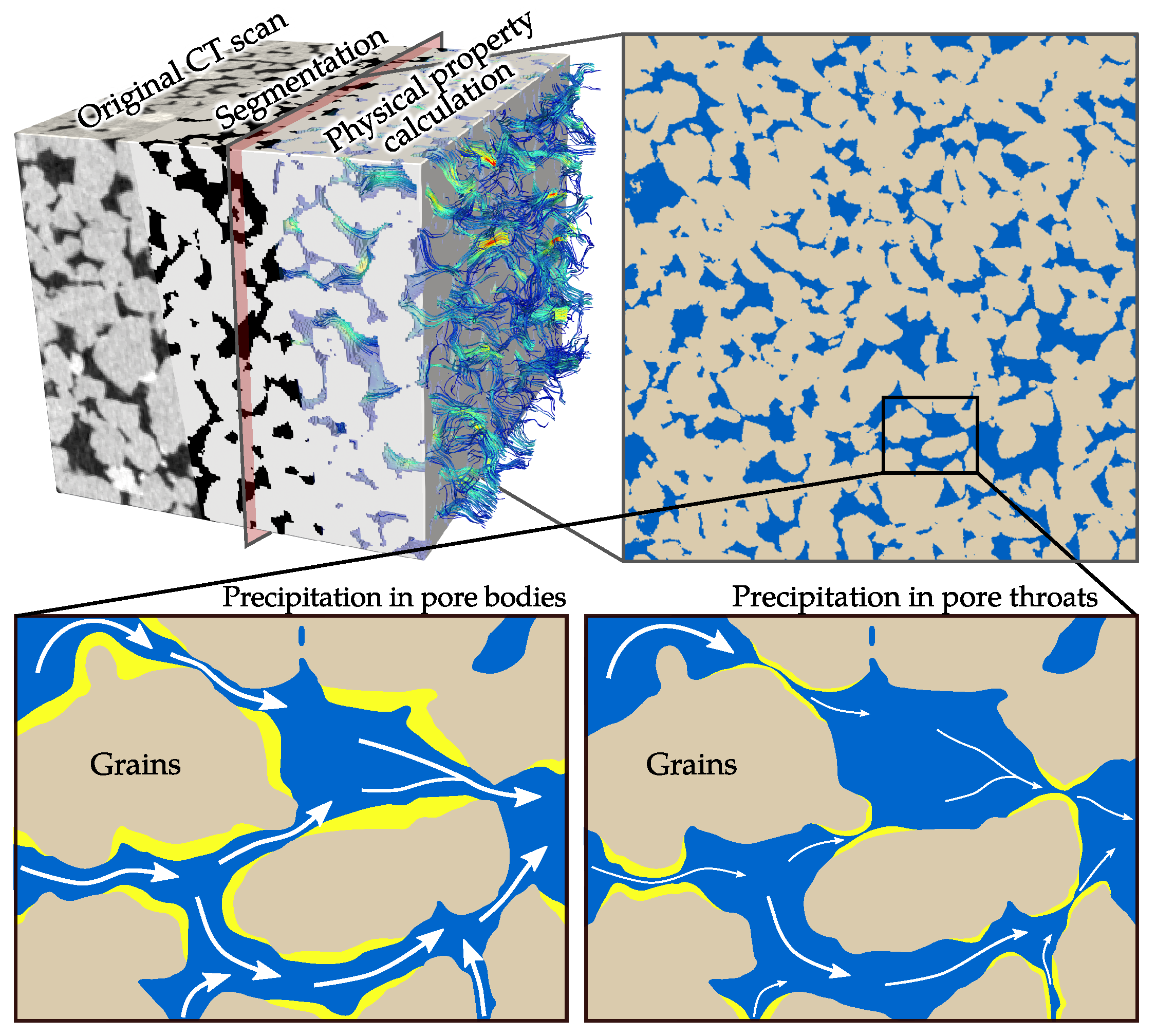
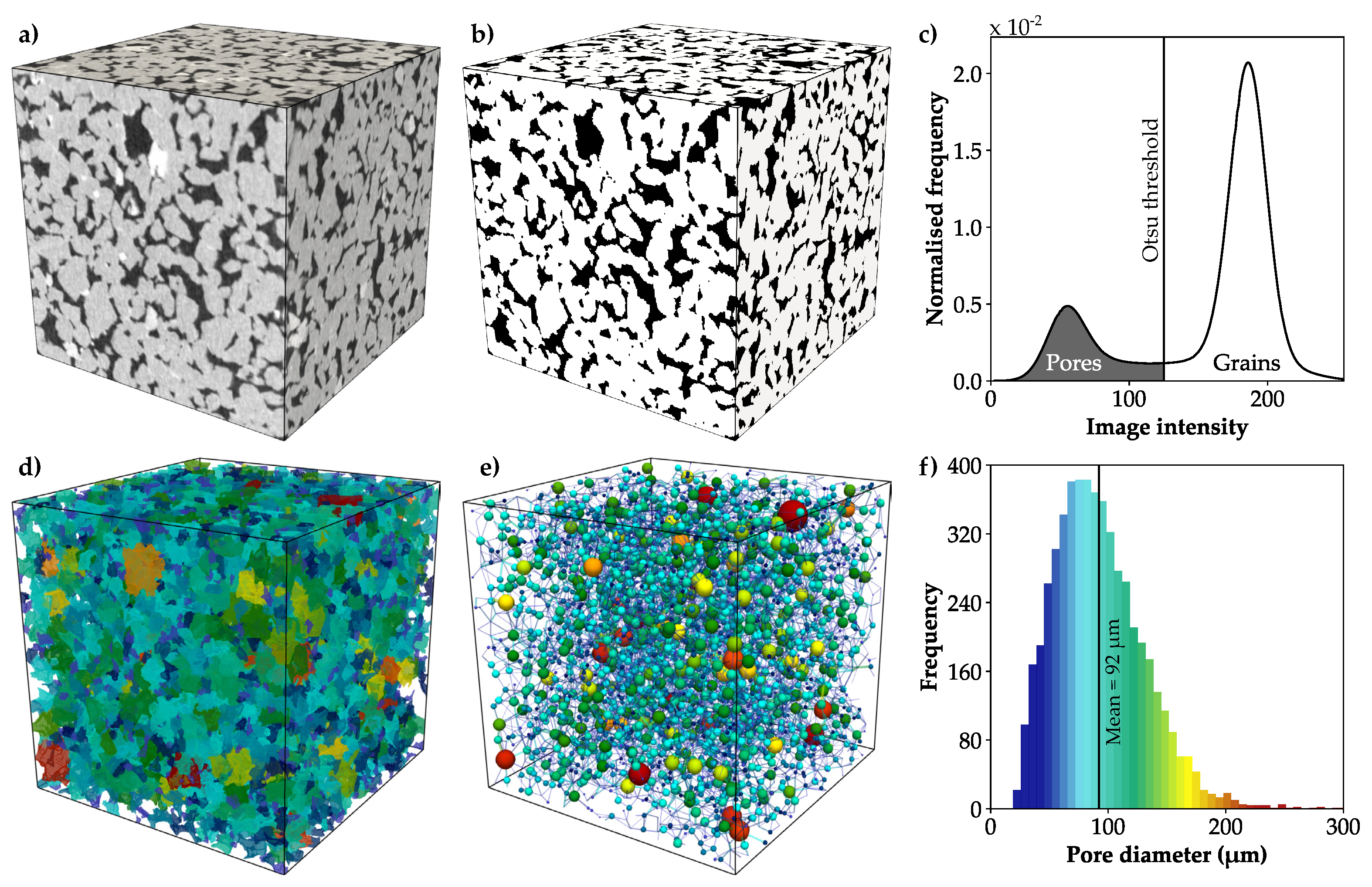
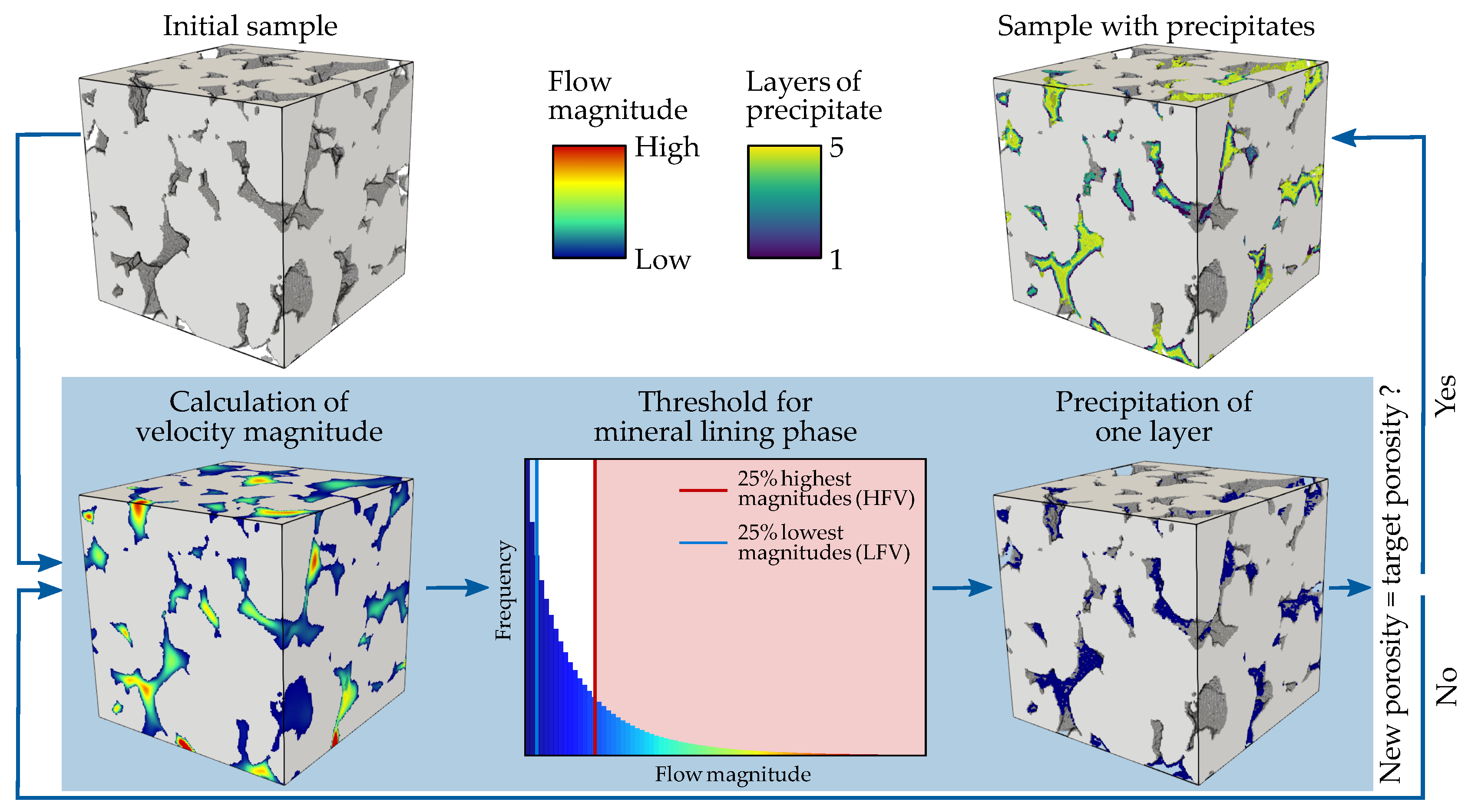


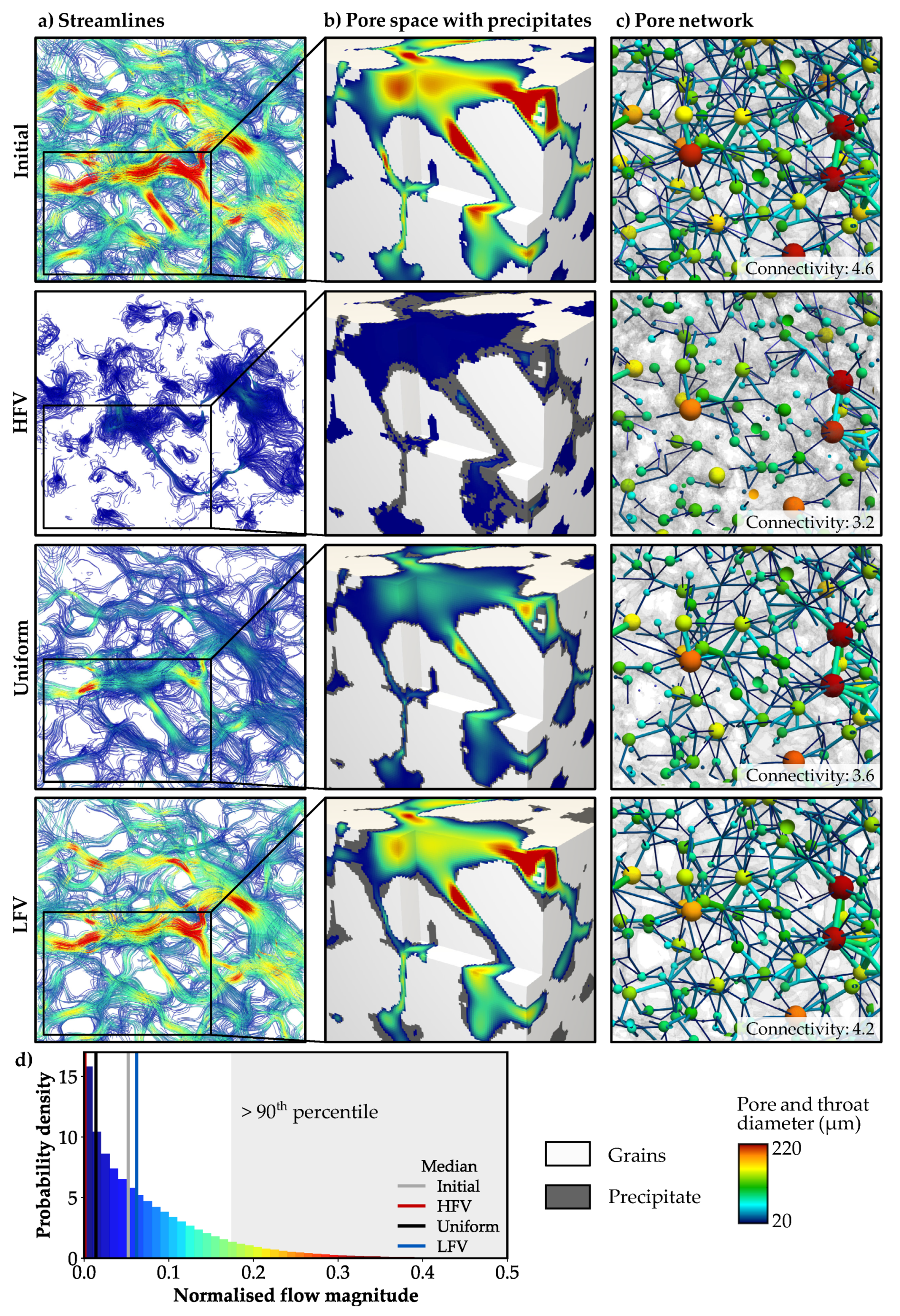
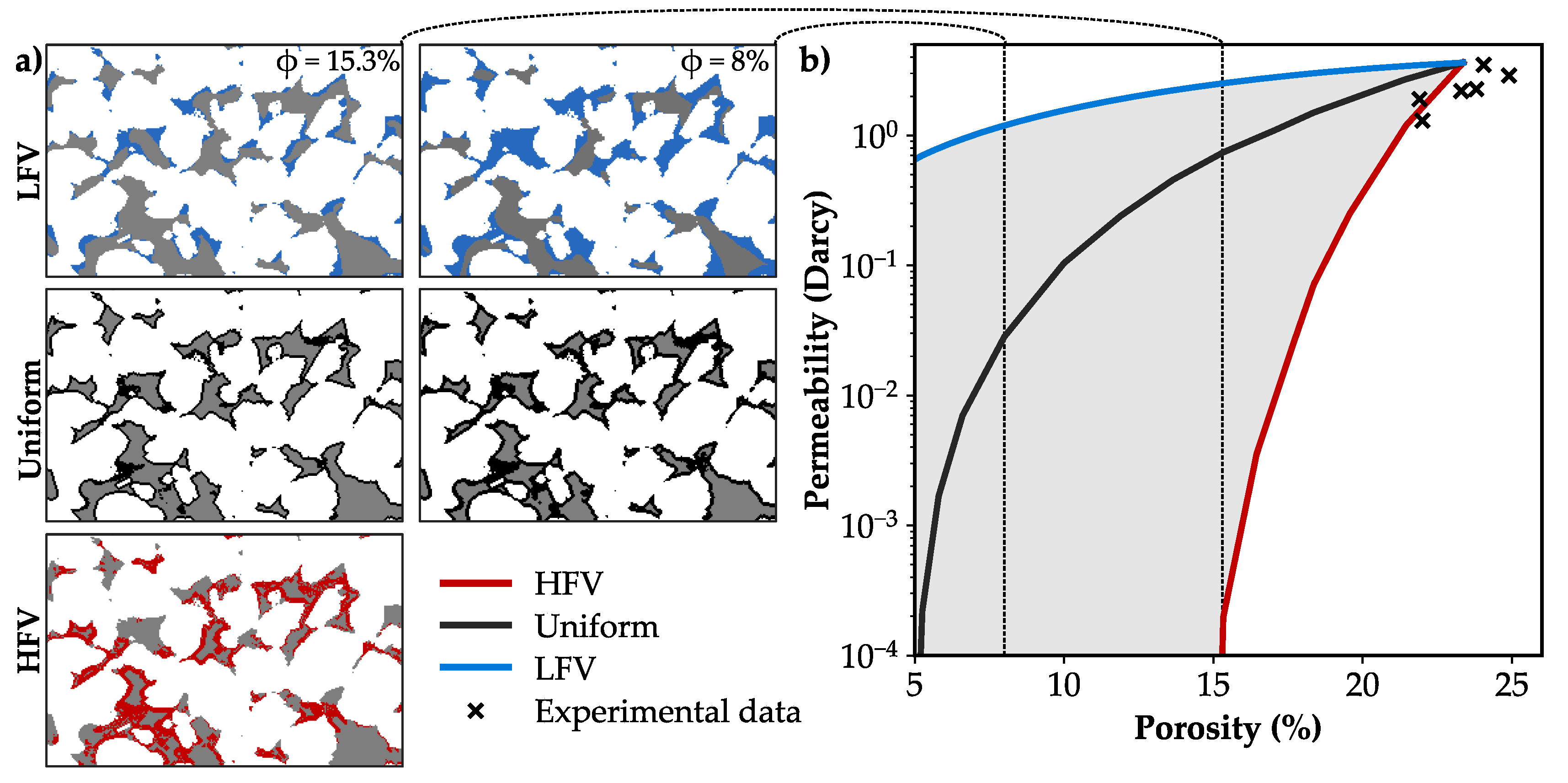
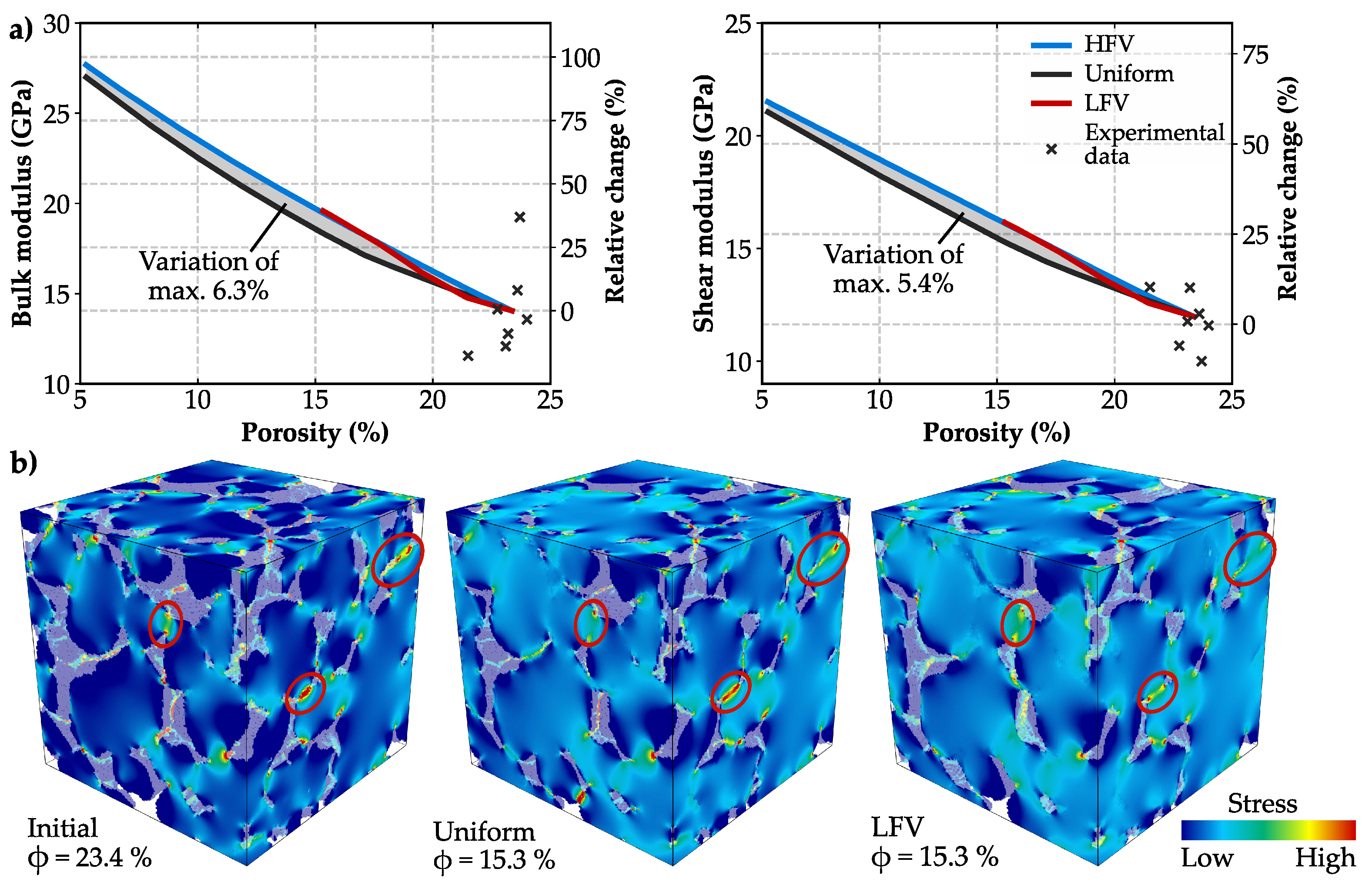
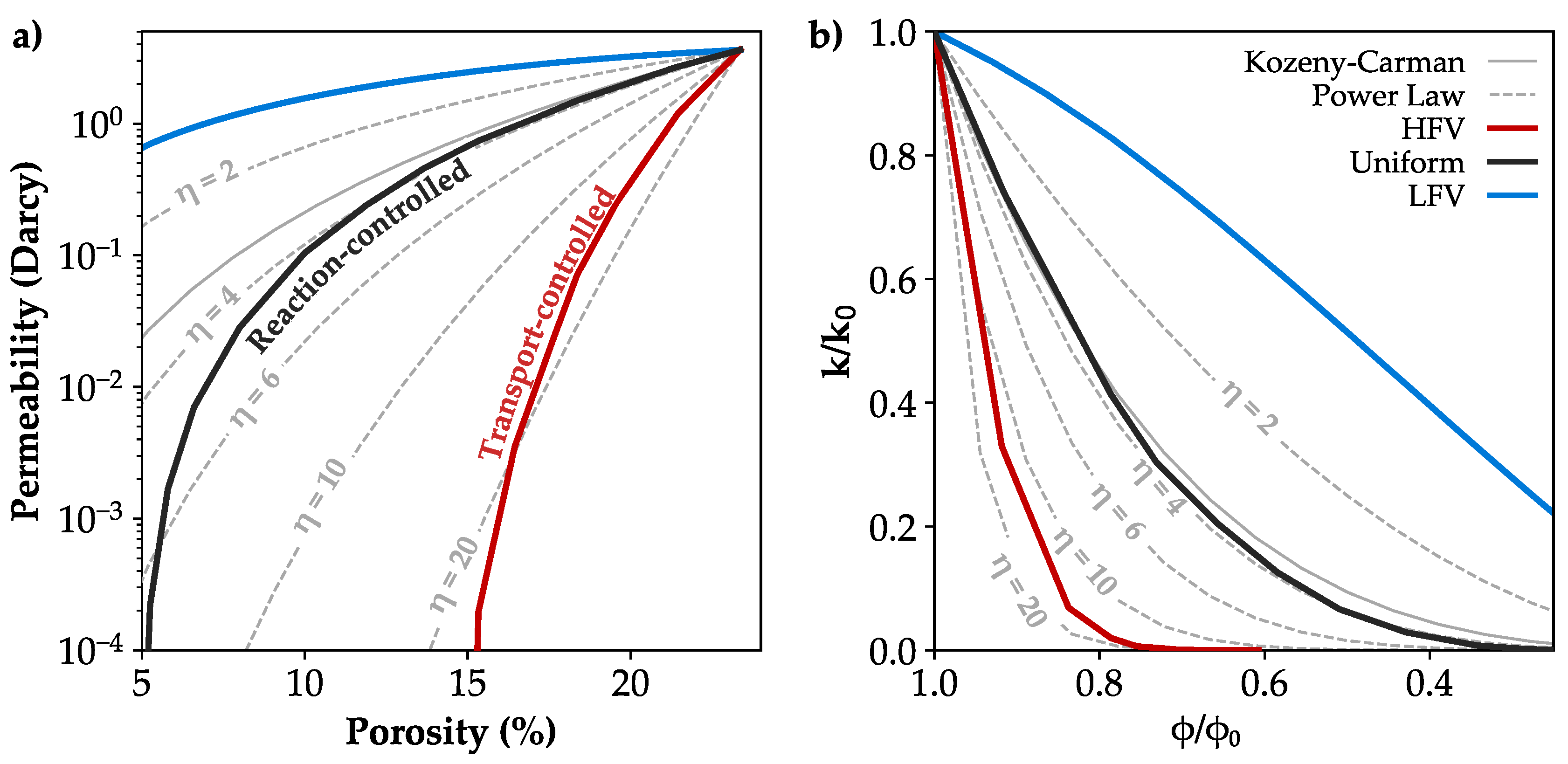
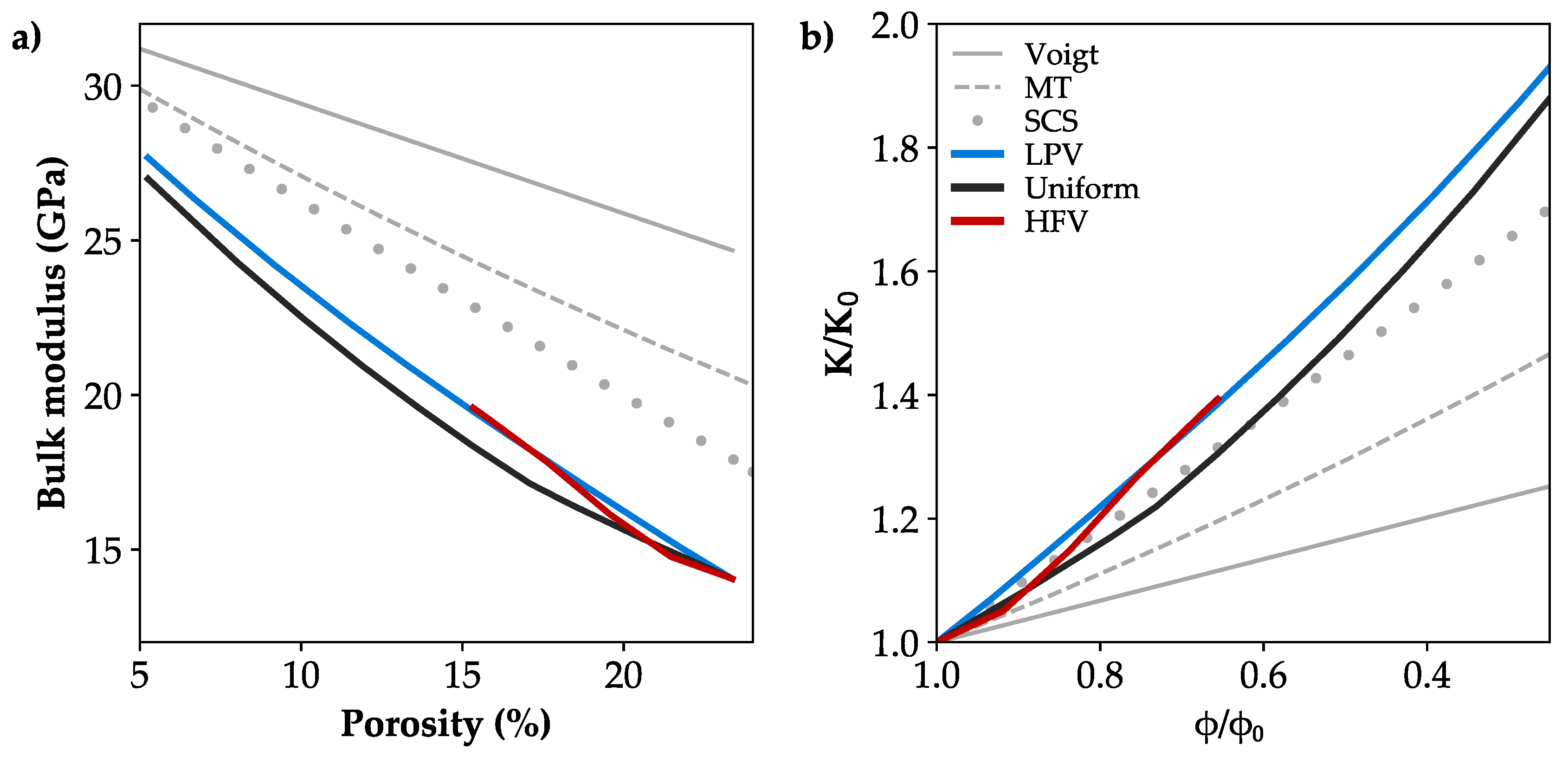
| Mineral | Bulk Modulus (GPa) | Shear Modulus (GPa) | Reference |
|---|---|---|---|
| Quartz | 37.0 | 44.0 | [66] |
| Quartz (calibrated) | 32.2 | 28.3 | Present study |
| Calcite (amorphous) | 35.5 | 14.0 | [76] |
| Pore space | 0 | 0 |
| Scenario | Porosity (%) | Throat Diameter (μm) | Pore Diameter (μm) | Connectivity | Sphericity |
|---|---|---|---|---|---|
| Initial | 23.4 | 22 | 92 | 4.6 | 0.64 |
| HFV | 15.3 | 9 | 78 | 3.2 | 0.47 |
| Uniform | 15.3 | 16 | 76 | 3.6 | 0.60 |
| LFV | 15.3 | 23 | 82 | 4.2 | 0.70 |
| Scenario | Absolute Porosity (%) | Effective Porosity (%) | Median of Normalised Flow Magnitude | Permeability (Darcy) |
|---|---|---|---|---|
| Initial | 23.4 | 23.3 | 5.2 × 10 | 3.63 |
| HFV | 15.3 | 3.5 | 3.7 × 10 | 2 × 10 |
| Uniform | 15.3 | 15.2 | 1.4 × 10 | 0.74 |
| LFV | 15.3 | 15.3 | 6.4 × 10 | 2.52 |
© 2020 by the authors. Licensee MDPI, Basel, Switzerland. This article is an open access article distributed under the terms and conditions of the Creative Commons Attribution (CC BY) license (http://creativecommons.org/licenses/by/4.0/).
Share and Cite
Wetzel, M.; Kempka, T.; Kühn, M. Hydraulic and Mechanical Impacts of Pore Space Alterations within a Sandstone Quantified by a Flow Velocity-Dependent Precipitation Approach. Materials 2020, 13, 3100. https://doi.org/10.3390/ma13143100
Wetzel M, Kempka T, Kühn M. Hydraulic and Mechanical Impacts of Pore Space Alterations within a Sandstone Quantified by a Flow Velocity-Dependent Precipitation Approach. Materials. 2020; 13(14):3100. https://doi.org/10.3390/ma13143100
Chicago/Turabian StyleWetzel, Maria, Thomas Kempka, and Michael Kühn. 2020. "Hydraulic and Mechanical Impacts of Pore Space Alterations within a Sandstone Quantified by a Flow Velocity-Dependent Precipitation Approach" Materials 13, no. 14: 3100. https://doi.org/10.3390/ma13143100





